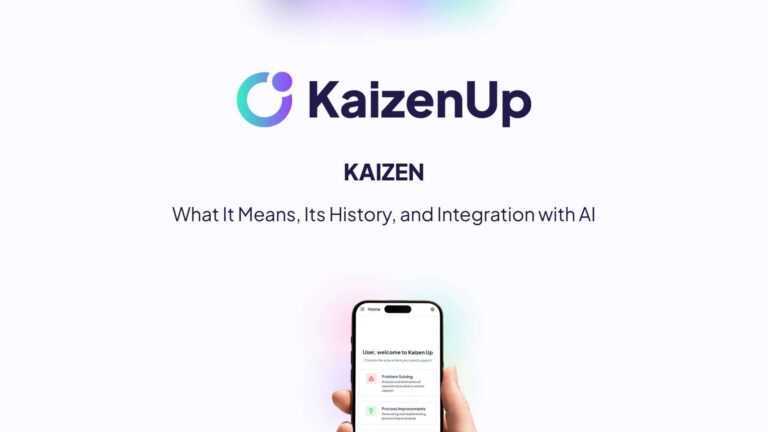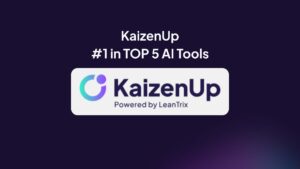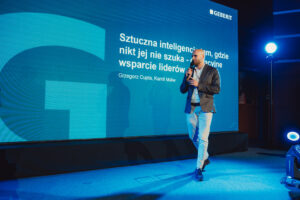Kaizen is a Japanese philosophy and business practice that focuses on continuous improvement through small, incremental changes. The word Kaizen literally combines the Japanese words for “change” (kai) and “good” (zen), essentially meaning “change for the better.” What makes Kaizen powerful is its emphasis on involving everyone in an organization – from top management to frontline workers – in constantly looking for ways to improve processes, reduce waste, and enhance quality. In this in-depth article, we will explore what Kaizen means in practice, trace its origins and evolution, examine how it’s applied across various industries (from manufacturing to services and even marketing), and discuss how Kaizen is integrating with modern technologies like artificial intelligence. Finally, we’ll look at KaizenUp, an example of a modern application that supports Kaizen activities in production and service processes.
What is Kaizen?
Kaizen is often defined as continuous improvement. Rather than pursuing large, drastic innovations all at once, Kaizen encourages making many small, ongoing improvements that accumulate to significant benefits over time. The core idea is that every process, no matter how efficient it appears, can be improved. Key principles of Kaizen include: empowering employees to speak up with ideas, systematically eliminating waste and inefficiency, standardizing best practices, and fostering a culture where improving the way work is done becomes a daily habit.
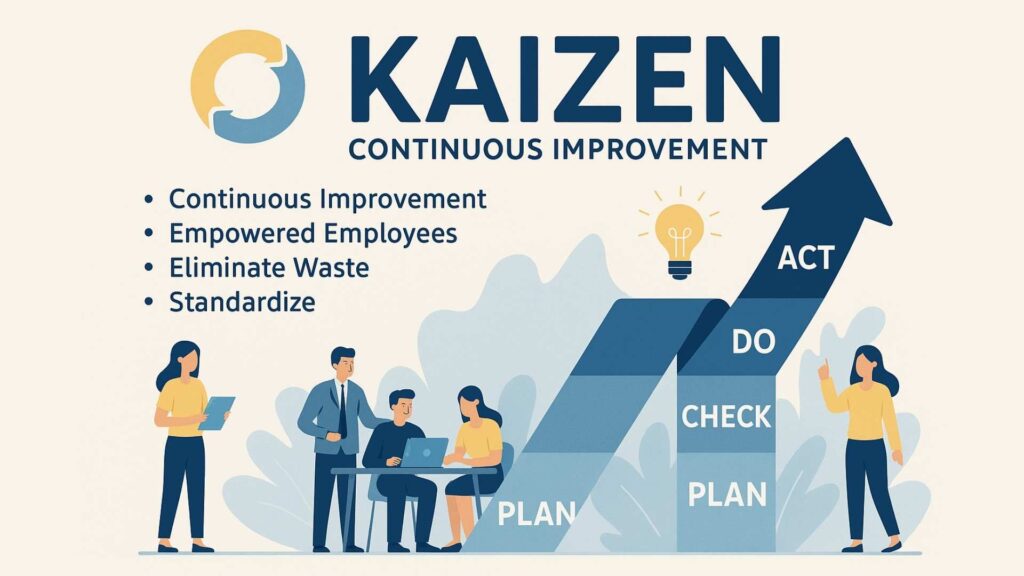
In practical terms, Kaizen is implemented through a cycle of planning and action. A well-known framework used in Kaizen is the PDCA cycle (Plan-Do-Check-Act), which provides a structured approach to continual improvement. The PDCA cycle works as follows:
-
Plan: Identify an area or process that needs improvement and devise a plan or change aimed at improving it. This involves analyzing the current situation, finding the root cause of any problems, and proposing a solution or small change.
-
Do: Implement the proposed change on a small scale (pilot it). This could mean testing a new method, rearranging a workflow, or introducing a new tool in a controlled way.
-
Check: Measure and evaluate the results of the change against the expected outcomes. Did the process improve? Gather data and feedback to see if the change had the desired effect or if it caused any new issues.
-
Act: Based on the results, decide on the next steps. If the change was successful, implement it on a broader scale and standardize the new process. If it wasn’t successful, learn from the experiment and refine your approach. Then repeat the cycle, planning new improvements.
This iterative PDCA process ensures that improvement is not a one-time event but an ongoing journey. Kaizen creates a mindset of continuous learning where even small wins are celebrated, and setbacks are seen as lessons for the next cycle.
By applying Kaizen consistently, organizations can achieve numerous benefits: increased efficiency and productivity, higher quality products and services, reduced costs by cutting out waste, safer and more organized workplaces, and a more engaged workforce. Employees feel valued because their ideas can directly shape improvements, which boosts morale and teamwork. In essence, Kaizen turns continuous improvement into a daily practice and a core part of an organization’s culture.
Origins and History of Kaizen
The philosophy of Kaizen has its roots in Japan’s post-World War II era. In the late 1940s and 1950s, Japanese industry was rebuilding and looking for ways to catch up and compete globally. During this time, Japan received input from several American quality management experts. Notably, W. Edwards Deming, an American statistician, played a pivotal role in introducing modern quality control and process improvement techniques to Japanese engineers and managers. Deming taught that improving quality (and reducing variation in processes) would increase productivity and lower costs – a message that resonated deeply in post-war Japan. He advocated a continuous cycle of planning, doing, checking, and acting (the PDCA cycle mentioned earlier) to drive ongoing improvements. Japanese companies eagerly adopted these ideas, laying the groundwork for what would become the Kaizen approach.
One of the most famous early adopters of continuous improvement was Toyota. In the 1950s, Toyota Motor Corporation, under engineers like Taiichi Ohno, developed the Toyota Production System – a precursor to what we now call Lean Manufacturing. A core element of Toyota’s approach was eliminating waste (muda in Japanese) and improving efficiency at every step of production. The company encouraged workers on the assembly line to spot problems or inefficiencies and suggest solutions immediately. This practice of empowering every employee to contribute ideas for improvement became known as Kaizen within Toyota. For example, if a worker noticed a tool was hard to reach and it slowed assembly, they might suggest repositioning the tool – a small change, but one that could save time and effort. Toyota institutionalized this mindset through mechanisms like Kaizen suggestion schemes (Kaizen Teian) and regular team meetings to discuss improvements. Over time, thousands of these small improvements led to big gains: faster production times, lower costs, higher quality, and ultimately Toyota’s rise as a global automotive leader. This success story showcased the power of Kaizen in manufacturing.
The term Kaizen (as a concept of continuous improvement) was popularized globally in the 1980s. In 1986, Japanese management consultant Masaaki Imai published a landmark book titled “Kaizen: The Key to Japan’s Competitive Success.”
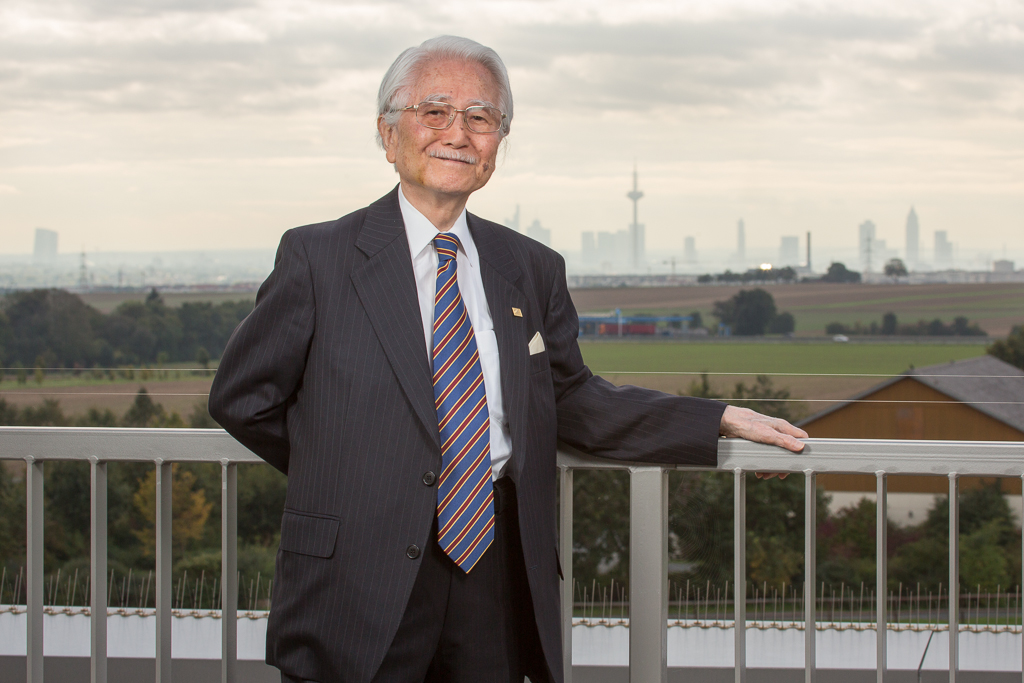
In this book, Imai introduced Western audiences to the term Kaizen and explained how Japanese companies had embraced continuous improvement to achieve superior performance. He emphasized that Kaizen is not just a set of tools, but a culture – one that focuses on process over results, long-term improvements over short-term fixes, and people-driven solutions on the shop floor. The same year, Imai also founded the Kaizen Institute to teach and help companies around the world implement these practices. This was a turning point where Kaizen began to be adopted internationally.
Throughout the late 1980s and 1990s, many companies in the U.S., Europe, and elsewhere started implementing Kaizen or similar continuous improvement programs. It often went hand-in-hand with the rise of Total Quality Management (TQM), Training Within Industry and Lean Management in the West. Manufacturers such as Ford, General Motors, and Motorola studied Japanese methods to improve their own processes. They organized “Kaizen events” (also called Kaizen blitzes) – short, focused workshops where cross-functional teams would analyze a process and implement improvements rapidly. Beyond manufacturing, service companies and government organizations also began using Kaizen principles to streamline their operations and improve quality.

By the 2000s, Kaizen had become a globally recognized approach, not limited to Japan. It proved adaptable to different cultures and industries because at its heart, it’s about human ingenuity and common-sense improvements. Today, Kaizen is practiced in organizations of all kinds around the world – from factories and hospitals to software companies and even small businesses. It has also influenced personal development philosophies, where individuals apply Kaizen by making small daily improvements in habits or skills. Over decades, the Kaizen philosophy has evolved but its essence remains the same: no process is ever perfect, and continuously making things better – no matter how small the step – is the surest path to excellence.
Kaizen Across Industries
Originally, Kaizen gained fame in manufacturing, but its versatility means it can be applied across virtually all industries and business functions. Any organization or team that has processes can use continuous improvement to do things more efficiently, effectively, and flexibly. Let’s look at how Kaizen works in different contexts, with examples:
Manufacturing and Production
Manufacturing is the birthplace of Kaizen, and it remains the classic example of continuous improvement. In factories, Kaizen is used to streamline production lines, improve product quality, and reduce wastes like excess inventory or unnecessary motion. The automotive industry provides a textbook case: Toyota’s Kaizen approach, as mentioned, enabled it to outcompete many rivals. Toyota encouraged workers to implement hundreds of small fixes – from rearranging tools for better ergonomics to tweaking machine settings for consistency – resulting in cumulative huge efficiency gains. This idea of engaging every operator in problem-solving was revolutionary and has since been emulated by countless manufacturers.
Other manufacturing companies also credit Kaizen for their success. For instance, Canon, the electronics and camera manufacturer, adopted Kaizen principles in its production system. By continuously identifying inefficiencies on the assembly line and improving workflows, Canon was able to shorten production cycles and respond faster to market demands. They used visual management boards displaying real-time production metrics to all employees, so if something went off standard, it was immediately noticed and corrected. Small improvements like rearranging a component’s supply closer to the point of use, or adjusting the sequence of assembly tasks, led to fewer delays and defects. Over time, these incremental changes significantly improved Canon’s productivity and product quality.
Manufacturers in industries from aerospace to food processing implement Kaizen through daily team huddles, suggestion programs, and periodic Kaizen events. The results often include shorter lead times, lower defect rates, safer work environments, and cost savings. In summary, Kaizen remains a cornerstone of modern production systems worldwide, enabling companies to continuously refine how products are made.
Service and Office Environments
Kaizen is not just for factories – it’s equally effective in service industries and office-based work. Service organizations use Kaizen to improve customer experience, speed up service delivery, and eliminate bureaucratic waste. For example, in the banking and finance sector, some banks have used Kaizen to streamline processes like loan approvals or account opening. By mapping out each step and removing redundant paperwork or unnecessary approvals, they can shorten the turnaround time for customers. Small changes such as simplifying a form or automating a manual data entry task can greatly reduce waiting times and errors, leading to happier customers.
In retail and hospitality, continuous improvement might involve employees regularly brainstorming ways to enhance customer service. A large retailer like Tesco in the UK famously used Kaizen by empowering store employees to suggest improvements in store layout and checkout processes. One outcome was rearranging stores for smoother customer flow and adding self-checkout stations to reduce queue times. These minor adjustments led to customers spending less time in line and a more pleasant shopping experience, which in turn improved sales.
Office environments (sometimes called administrative processes or knowledge work) also benefit from Kaizen. Ford Motor Company, for instance, applied Kaizen in its offices to improve administrative workflows. Teams examined routine processes – such as how documents were managed or how meetings were conducted – and found ways to make them more efficient. In one case, Ford restructured its internal document handling system, making information easier to find, which saved employees significant time that was previously lost searching for files. They also cut down on unnecessary meetings and streamlined communication channels. Each individual change was small (like a new filing protocol or a standardized email procedure), but together these Kaizen efforts made the office run much more smoothly and productively.
Even marketing and sales teams use Kaizen principles. In marketing, this might involve continuously analyzing campaign results and making incremental tweaks to improve performance – for example, doing A/B tests on a website to gradually increase conversion rates, or regularly updating keywords and ad copy in an online ad campaign to improve click-through rates. Rather than launching one huge marketing overhaul, teams embrace an iterative approach: test a small change, learn from the data, and then refine the strategy. Over time, these ongoing optimizations can dramatically improve marketing ROI. The same mindset can be applied in sales processes, customer support (finding small ways to resolve customer issues faster and better), and virtually any service process. Kaizen in service and office settings leads to outcomes like faster service delivery, higher customer satisfaction, and leaner, less frustrating workflows for employees.
Healthcare
The healthcare industry has widely adopted Kaizen to improve patient care and operational efficiency. Hospitals and clinics around the world have introduced Kaizen (often as part of Lean Healthcare initiatives) to streamline everything from patient admissions to surgical procedures. A notable example is the Virginia Mason Medical Center in Seattle, which became a pioneer in applying Kaizen in healthcare. By embracing continuous improvement (which they sometimes referred to as the “Virginia Mason Production System”), the hospital achieved impressive results: they cut down the time patients spent waiting for treatments, reduced medical errors, and improved overall quality of care.
How did they do this? They formed multidisciplinary teams – doctors, nurses, pharmacists, administrators – to examine processes and identify small changes that could make a big difference. For instance, they optimized the way medications were delivered to patients in the hospital. Through a Kaizen event, the staff mapped out the steps for prescribing, dispensing, and administering medicine. They found delays and opportunities for error, then implemented fixes such as better coordination between pharmacy and nursing or using electronic reminders for timely medication delivery. These adjustments reduced delays in giving patients their medications and prevented mistakes, directly improving patient outcomes and safety.
Similarly, other hospitals have applied Kaizen to processes like operating room turnaround time (reducing the time to clean and prep between surgeries), billing procedures, and even how supplies are organized in nursing stations. Frontline healthcare workers are encouraged to suggest ideas – for example, a nurse might propose a new layout for the supply closet to save steps during emergencies, or a lab technician might find a simpler way to label samples to avoid confusion. Over time, continuous improvement in healthcare leads to fewer errors, lower costs, less waste of supplies, and more time that staff can spend on patient care rather than chasing paperwork. Most importantly, it contributes to saving lives by making healthcare processes more reliable and efficient through many small, smart changes.
Technology and Startups
In the technology sector – including software development, IT services, and startups – Kaizen is embraced as a way to keep improving products and processes rapidly. Tech companies may not use the word “Kaizen” explicitly, but the concept of continuous improvement is embedded in practices like Agile development. Agile teams work in short cycles (e.g. sprints) and after each cycle, they hold a retrospective meeting to discuss what went well and what can be improved for next time. This is pure Kaizen spirit: regularly reflecting and implementing small tweaks to how the team works. Over successive iterations, these teams become more efficient and effective at delivering software. They might, for example, identify that code reviews are causing delays, and then agree to a small change like doing reviews in parallel with coding to save time – a modest process fix that yields faster releases.
Many successful tech companies encourage a culture of experimentation and learning, which is essentially Kaizen. Startups often talk about “iterating” their product based on user feedback – this means they release early versions, gather feedback, and continuously refine the product with improvements. Rather than betting everything on a perfect big launch, they use incremental enhancements to gradually achieve a great product-market fit. This continuous improvement mindset helps them adapt quickly in fast-changing markets.
Even in IT operations and infrastructure, Kaizen is applied via methodologies like DevOps, which encourages constant experimentation to improve deployment processes, automate routine work, and reduce system downtimes. The result of applying Kaizen in tech includes better software quality, faster delivery of updates, and teams that constantly refine their efficiency. In essence, the rapid pace of the tech industry makes continuous improvement not just a philosophy but a necessity – and those practicing Kaizen-style iteration tend to outpace those who do not.
As these examples show, Kaizen’s principle of ongoing, small improvements can be adapted to any environment – be it a factory, a bank, a hospital, a marketing team, a software studio, or beyond. The common thread is a commitment to constantly ask, “How can we do this better?” and empowering the people involved in the work to drive those improvements.
Kaizen in the Age of Artificial Intelligence
In recent years, the rise of artificial intelligence (AI) and advanced data analytics has opened new frontiers for continuous improvement. At first glance, Kaizen and AI might seem unrelated – one is a human-driven philosophy, the other a technology. In reality, they complement each other powerfully. Organizations with a strong Kaizen culture are often best positioned to leverage AI effectively, because they already focus on optimizing processes and are open to innovation. Conversely, AI can supercharge Kaizen efforts by providing deep insights and automation that were not possible before.
One important thing businesses have learned is that adopting AI without a solid process foundation can lead to disappointing results. If a company simply throws AI into a chaotic, inefficient process, it might just amplify the chaos. On the other hand, if you use Kaizen to streamline and standardize your operations first, AI can then be applied in a targeted way to make a good process even better. In fact, many industry leaders have found that the true value of AI is realized when it’s embedded in a culture of continuous improvement – where people are constantly refining workflows and then using AI tools to assist in that refinement. AI becomes a powerful enabler for the people on the ground who are driving improvements.
Here are several ways in which AI and automation technologies are being integrated with Kaizen principles to enhance continuous improvement:
-
Data-Driven Insights: AI systems excel at analyzing large volumes of data quickly. In a Kaizen context, this means AI can crunch process data (production numbers, cycle times, error rates, customer feedback, etc.) to identify patterns and pinpoint inefficiencies that humans might overlook. For example, an AI analytics tool might reveal that a particular step in a process is consistently causing delays at 3 PM each day, or that a subtle combination of factors leads to higher defect rates on a production line. These insights highlight opportunities for improvement which teams can then address. Essentially, AI provides a supercharged “Check” phase in the PDCA cycle by monitoring and analyzing performance in real-time.
-
Predictive Maintenance and Quality Control: In manufacturing and other asset-heavy industries, AI is used for predictive maintenance – a key continuous improvement strategy. Sensors on machines feed data to AI algorithms that can predict when equipment is likely to fail or when it’s starting to operate sub-optimally. Instead of waiting for a breakdown (and suffering unplanned downtime), companies can proactively service the machine at a convenient time, thereby continuously improving uptime and reliability. Similarly, AI-powered vision systems can inspect products for defects far faster and more accurately than the human eye. By catching quality issues early (or predicting them before they happen), these AI systems help eliminate waste (scrap, rework) and improve quality, which is exactly in line with Kaizen’s goals of “built-in quality” and doing things right the first time.
-
Process Optimization and Automation: AI can take on complex optimization problems that have many variables, something traditionally done via trial-and-error in Kaizen. For instance, in logistics and supply chain operations, AI algorithms can optimize delivery routes or inventory levels much more efficiently, reducing delays and costs. In scheduling and staffing, AI can help create optimal work schedules that improve productivity and employee work-life balance. Moreover, robotic process automation (RPA) – software “bots” that perform repetitive digital tasks – can be implemented as part of Kaizen to automate routine steps that were previously done manually. By automating low-value, repetitive tasks (like data entry or report generation), employees are freed up to focus on more value-adding improvement work. This aligns with Kaizen by eliminating the waste of human potential on monotonous tasks.
-
Decision Support and Idea Generation: AI can serve as a decision-support tool, providing teams with recommendations or simulations when they are planning improvements. Modern AI systems (including machine learning models and even generative AI) can simulate the impact of a change before it’s implemented. For example, an AI might model how changing a supply chain supplier could affect delivery times and costs, or it might suggest the most efficient way to reconfigure a factory layout given certain constraints. In more experimental forms, AI chatbots can be used in brainstorming sessions to generate a list of potential solutions to a problem, which the team can then evaluate. While humans still make the decisions, AI can expand the options and provide evidence-based suggestions, making the “Plan” stage of PDCA more robust.
-
Personalization and Customer Feedback Loops: In service industries and marketing, AI helps implement Kaizen by enabling personalized experiences and rapid feedback. For example, AI-driven analytics on a website can continuously test and learn which content or design leads to better user engagement – essentially an ongoing series of micro-improvements to the customer experience. Customer service chatbots use AI to handle common inquiries instantly, reducing wait times (an improvement for customer satisfaction) while also collecting data on what customers ask. Companies then analyze this data to identify service processes that could be improved or information that could be clarified proactively, feeding into the next cycle of improvement. In short, AI helps businesses stay closely attuned to customer needs and make continuous adjustments to improve service quality and marketing effectiveness.
By integrating AI with Kaizen, organizations create a virtuous cycle: Kaizen optimizes the processes, AI provides deeper insight and efficiency for further optimization. For instance, think of a manufacturing firm that has implemented standard work (everyone doing a task in the best known way). With that stability in place, they deploy AI to monitor the production in real-time for any deviation or hint of a problem. Workers on the floor receive alerts and suggestions from an AI system when something could be improved or if an issue is emerging. They can then address it immediately – which is continuous improvement happening almost instantaneously.
It’s important to note that Kaizen’s human-centric philosophy remains crucial even with advanced AI tools. The role of AI is to augment human decision-making and creativity, not replace it. Kaizen teaches that the people who do the work often have the best ideas for improving it. AI can provide them with better information and take over drudge work, but human judgment is key in interpreting insights and implementing meaningful changes. In companies that successfully combine AI and Kaizen, employees are not sidelined by technology; instead, they are empowered by it. They receive training to work with AI tools and are encouraged to continue suggesting improvements – some of which might involve deploying new tech, while others might be purely procedural or behavioral changes.
In summary, we’re entering an era where Kaizen 2.0 (so to speak) merges the timeless principles of continuous improvement with cutting-edge AI capabilities. Organizations that cultivate a continuous improvement culture are finding that AI can accelerate and amplify their improvements, driving efficiency and innovation to new heights. Meanwhile, those that try to implement AI without such a culture may struggle. The lesson is clear: the future belongs to companies that can blend human ingenuity and continuous improvement mindset with the power of artificial intelligence.
KaizenUp: A Modern Platform for Continuous Improvement
As the Kaizen approach has evolved into the digital age, a variety of tools and applications have emerged to support continuous improvement activities. One such example is KaizenUp – an application designed to help organizations implement and sustain Kaizen in both production and service environments. In essence, KaizenUp is a modern digital platform that acts as a facilitator for Kaizen practices, making it easier for teams to collaborate on improvements and track progress.
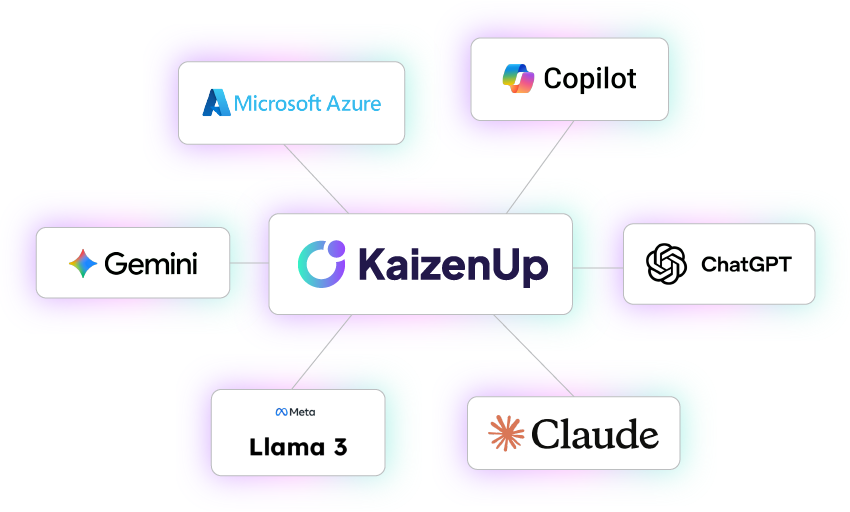
What does KaizenUp do? It provides a structured way for companies to capture improvement ideas, manage Kaizen projects, and ensure that small changes lead to big results. Imagine a factory floor or an office where any employee with an idea to make something better can quickly log that idea into a system. KaizenUp serves as that system: team members can submit suggestions (for example, a faster way to complete a certain task or a fix for a recurring error), which are then visible to managers and colleagues. The app can categorize and prioritize these ideas, making sure none are lost or ignored. This encourages broad participation, echoing the Kaizen principle that everyone’s input matters.
Once an idea is submitted, KaizenUp helps manage the PDCA cycle for it. Teams can create an action plan (Plan), assign responsibility and deadlines right within the app. As they implement the change (Do), they can document what was done and upload any relevant data or notes. Then, the results can be recorded (Check) – for instance, before-and-after metrics like time taken, error rate, cost savings, etc. KaizenUp might provide visual dashboards or reports to compare these metrics, so the team can easily see if the change was an improvement. Finally, if the idea is successful, the application can help standardize the new process (Act) by storing the updated procedure or checklist for everyone to follow. If the idea didn’t work out, it’s also documented, and the team can use that information to plan a new experiment. This creates an organizational memory of what improvements have been tried, which ones worked, and what was learned – preventing repeated mistakes and spreading successful practices faster.
Supporting both production and services: KaizenUp is built to be flexible so that it can be used in a manufacturing plant or in a service-oriented office. In a production setting, it might integrate with operational data systems – for example, pulling data from machines or production logs to help identify improvement opportunities or to automatically measure the impact of a change. It could send alerts when a process performance drifts from the norm, prompting a Kaizen investigation. In service processes, KaizenUp might integrate with workflow software or customer feedback systems. For instance, if customers are reporting a particular issue frequently, the platform can flag that trend so the team can initiate a Kaizen project to address the root cause. By bridging different departments and data sources, the application ensures that continuous improvement is not siloed – improvements in one department (say, reducing billing errors in finance) can be shared and communicated to other departments (like operations or sales) through the common platform.
Another advantage of a tool like KaizenUp is engagement and gamification. To keep the Kaizen spirit alive, the app might include features like upvoting ideas, recognizing employees who contribute the most suggestions or deliver successful improvements, and sharing “Kaizen success stories” across the organization. This maintains enthusiasm and a positive competitive spirit around continuous improvement. It sends the message that Kaizen is part of daily work, not an occasional special project.
KaizenUp and similar platforms often incorporate modern tech like cloud computing (so everyone can access it anywhere, even via mobile devices on a factory floor or at a client site) and sometimes even AI analytics. For example, the app could use AI to analyze the types of suggestions coming in and cluster them into themes, or to predict which types of improvements might yield the highest impact based on past data. While specifics will vary, the overarching goal is to use technology to support and scale the human-driven Kaizen process.
In conclusion, KaizenUp represents how the age-old Kaizen philosophy is being augmented by digital tools. It ensures that whether a company is dealing with physical production lines or intangible service processes, it has a central hub for its improvement efforts. By providing transparency (everyone can see the pipeline of improvement ideas and their status), accountability (tasks and results are clearly recorded), and knowledge sharing (lessons from one improvement can inform others), KaizenUp helps embed continuous improvement into the fabric of day-to-day operations.
The story of Kaizen – from its origins in post-war Japan to its integration with artificial intelligence and modern software – shows its enduring value. At its heart, Kaizen is about never being satisfied with the status quo and recognizing that countless small changes, driven by engaged people, lead to extraordinary outcomes. With tools like KaizenUp supporting these activities, and AI providing new insights, organizations today can carry the Kaizen ethos forward in more powerful ways than ever. By embracing Kaizen and the technologies that enhance it, companies in any industry can foster a culture of continuous improvement that drives sustainable success, innovation, and excellence for years to come.
